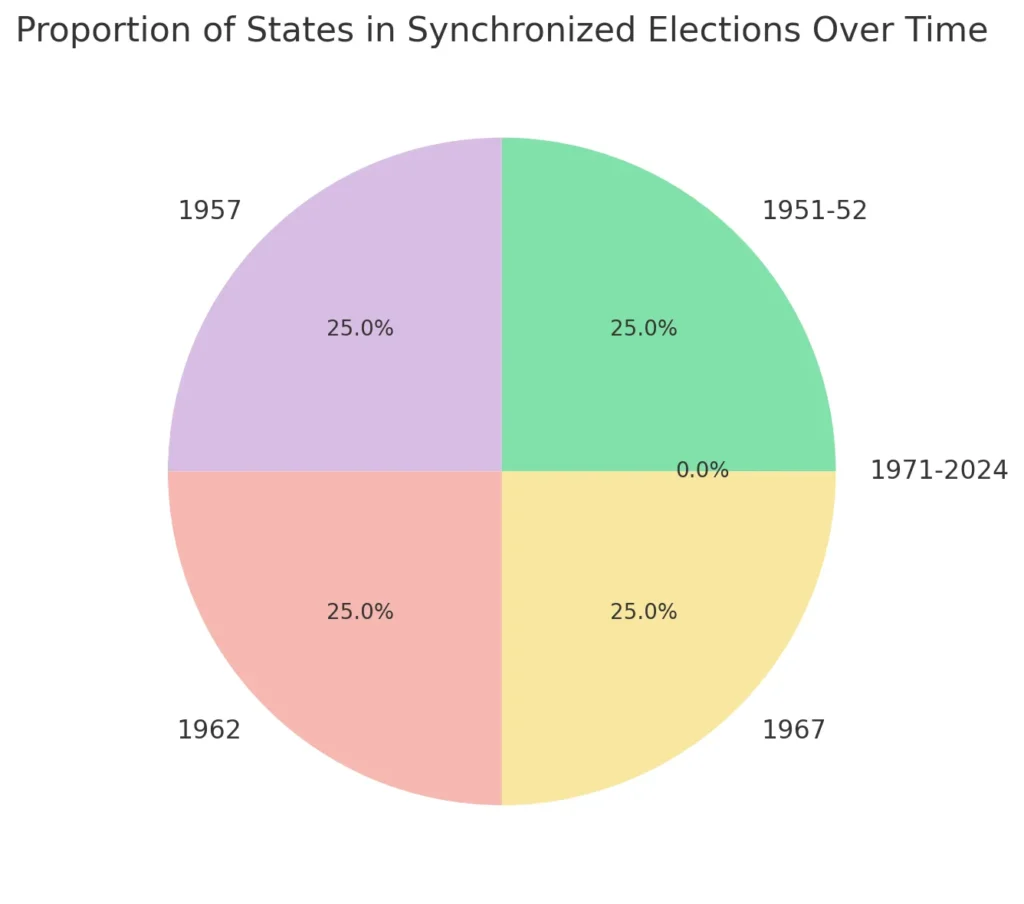One Nation One Election impact: The “One Nation, One Election” plan has started a big discussion across India. This idea suggests holding elections for the Lok Sabha and state assemblies at the same time. The goal is to make elections simpler and save money, but some people worry it could harm India’s federal system. Supporters believe it will help improve governance and lower election costs. On the other hand, critics fear it could give too much power to the central government and reduce the independence of state governments. In this article, we look at how this plan might affect India’s federal system.
- Avatar: Fire and Ash – जेम्स कैमरन दाबा नहीं हुआ AI का USE, कहानी में नया मोड़?
- Bappam TV Telugu 2025: Watch Your 100% Free Movies, APK, Downloads & Best Alternatives
- इतिहास अपने आप को दोहराता है… लेकिन नए अंदाज में! ये क्या बोल गए राकेश रोशन ऋतिक रोशन के लिए
- Sonakshi Sinha’s Jungle Adventure in Mount Abu: A New Film Shoot
- Anora Oscar Awards 2025 Highlights: A Night of Glamour and Inspiration

What is ‘One Nation, One Election’ and Why Is It Significant?
The “One Nation, One Election” (ONOE) idea aims to hold elections for the Lok Sabha and all State Assemblies at the same time. This would reduce the need for frequent elections. In the past, simultaneous elections were held in India from 1951 to 1967. However, this system was disrupted when assemblies and the Lok Sabha were dissolved at different times.
Key Points:
- ONOE proposes aligning all elections to a single schedule.
- It requires significant constitutional amendments to Articles 83, 172, 85, and 356.
- Supporters highlight cost savings and reduced disruption to governance caused by repeated elections.

How Would ‘One Nation, One Election’ Impact India’s Federal Structure?
- Centralization of Political Discourse
Simultaneous elections may prioritize national issues over regional concerns, leading to diminished attention for local problems. State-specific issues risk being sidelined during nationwide campaigns. - State Autonomy at Risk
States may lose their ability to act independently on their timelines. Aligning with the national election cycle could restrict states from dissolving their assemblies for local governance needs. - Impact on Regional Parties
Regional parties fear losing representation as national parties may dominate synchronized elections. This could undermine diversity in India’s political landscape.

Constitutional Provisions and Amendments Required for ONOE
| Constitutional Article | Amendment Impact |
| Article 83 | Adjust the Lok Sabha’s tenure to match state elections. |
| Article 172 | Align state assemblies’ duration with the central cycle. |
| Article 85 | Amend rules on Parliament sessions and dissolutions. |
| Article 356 | Redefine President’s Rule timelines to prevent disruptions. |
These amendments require a two-thirds majority in Parliament and approval from half of India’s states. This makes ONOE a significant legal and political challenge.
Economic and Administrative Benefits of ‘One Nation, One Election’
Supporters of ONOE highlight various advantages:
- Cost Efficiency: Conducting a single election cycle could reduce electoral expenses significantly.
- Focus on Governance: Governments will spend less time on campaigns and focus on delivering public services.
- Improved Voter Turnout: A synchronized election could encourage higher participation, as citizens vote for all levels simultaneously.
Despite these benefits, logistical challenges remain, such as ensuring adequate Electronic Voting Machines (EVMs) and security arrangements nationwide.
Key Challenges and Opposition to ONOE
While ONOE presents economic benefits, critics argue it poses substantial challenges:
- Logistical Complexity: Conducting elections simultaneously across 28 states and 8 union territories requires significant resources.
- Federalism Concerns: States fear losing autonomy and representation in a centralized political structure.
- Political Opposition: Regional parties and opposition leaders view ONOE as favoring national parties.
| Challenge | Explanation |
| Resource Availability | EVMs, security, and polling personnel at a large scale. |
| Federalism Threat | States may lose power to address local issues. |
| Political Opposition | Regional parties believe it favors central dominance. |
Global Examples of Simultaneous Elections
Countries like Sweden, South Africa, and Indonesia conduct simultaneous elections effectively. However, India’s diversity and federal structure make direct comparisons difficult. The implementation of ONOE must consider India’s unique political landscape to ensure fairness.
The Way Forward: Achieving Consensus
- Conducting comprehensive consultations with state governments and regional parties.
- Developing logistical frameworks to manage nationwide elections.
- Ensuring safeguards to protect federalism and regional representation.
Conclusion
The “One Nation, One Election” proposal aims to create a simpler election process in India. It promises to save costs and improve governance. However, it also raises concerns about India’s federal system and the independence of state governments. To make this idea work, careful planning, strong political agreement, and solid changes to the Constitution are needed.
As India considers this big change, it is important to ensure that the democratic and federal values in the Constitution are protected above all.
- Bihar Mahila Rojgar Yojana 2025: ₹10,000 का FREE स्टार्ट-अप, जाने कैसे करना है अप्लाई?
- PMAY-U 2.0 Angikaar 2025: अभियान शुरू — घर मुफ्त में बनाने का सुनहरा मौका, अब आवेदन कैसे करें?
- Silver Hallmark अब HUID के साथ – जेवर खरीदने में 100% भरोसा आपका जेबर असली है या नकली, ऐसे जाने?
- बिहार Rs 10,000 स्कीम: Mukhyamantri Mahila Rojgar Yojana – पहले काम या पहले पैसा?
- GST Slab Change: अब TV, AC, Small Cars सस्ते, Medicines पर सिर्फ 5% टैक्स!
FAQ Related To One Nation One Election impact
The “One Nation, One Election” proposal aims to synchronize elections for the Lok Sabha and state assemblies, reducing the frequency of elections and streamlining governance.
ONOE could centralize political discourse, reduce state autonomy, and impact regional parties’ ability to address local issues effectively.
Key benefits include reduced election costs, improved governance, and higher voter participation due to synchronized polling for all levels.









